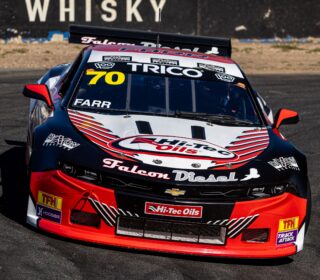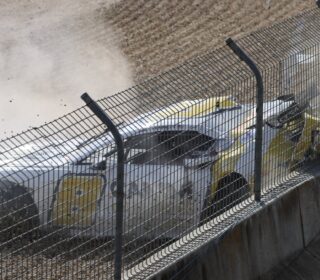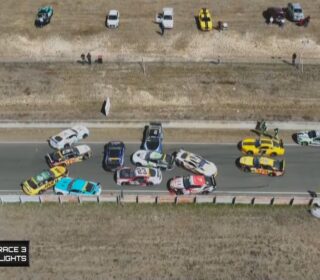HOW F1’S EARTH DREAM TURNED NIGHTMARE
WELL BEFORE Formula E was a concept and discussions about climate change felt less evangelical, Honda pioneered the racing green movement with their ‘Earth Dreams’ concept. However, as DALE RODGERS investigates, it did little to cover other inadequacies being experienced by the team at the time.
WORDS: Dale Rodgers IMAGES: Supplied / Honda F1 / Honda Media
In 2006 Honda was very upbeat about its performance in Formula 1. Jenson Button had delivered Honda’s first GP win in the modern era with an excellent victory in Hungary while both drivers finished the season well inside the Top 10 in the Championship.
As a constructor, hard work had also paid off and the Honda RA106 scored fourth comfortably ahead of the mid field pack and in reach of the big three – Renault, Ferrari and McLaren.
Matched with a budget primarily with Honda works money and the deep pockets of British American Tobacco, via global brands Lucky Strike and 555, Honda were ready to climb further up the Formula 1 ladder.
Jesnon Button and Rubens Barrichello were re-signed for 2007 but that was about the only positive that would come from the season.
The loss of BAT, as tobacco money was removed from global sponsorship rosters, was going to have an effect however few would have ever thought that Honda would decide on a strategic marketing position for 2007 which was a 180 degree turn around.
So was born My Earth Dreams.
The ‘livery launch’ for the RA107 took place at the Natural History Museum in London with a 100,000-pound extravaganza. What was revealed was a completely new take on the look of a Formula One car. Honda’s 2007 paint scheme did not use sponsorship branding but instead focused on Honda’s environmental desires.
The car was dubbed by some as ‘The Honda Earth car’ as the car’s livery depicted the planet Earth against the black background of space, with the only logos on the car being the Type R, Honda ‘H’, and the Bridgestone logo, all at the very front of the car. The rear wing featured the web address MyEarthDream.com and that was the extent of it. How high-profile partners such as Eneos, Fila, Ray Ban and Seiko were sold a no signage package is a miracle and of course history would show, unsustainable.

Nick Fry, Chief Executive Officer and Team Principal of Honda Racing was left to convince a questioning Formula 1 Media pack just what the strategy behind My Earth Dream was.
“What we decided to do was to try to raise people’s awareness of environmental issues,” said Fry at the launch.
“The whole philosophy behind it is that Grand Prix racing has more than 600 million people who watch it on a regular basis every year, so there’s a huge audience we can speak to. Honda is one of the top 20 best-known brands in the world, so working off the back of a fantastic brand label like that is very important. But it’s also got to have substance and we couldn’t do this if Honda hadn’t moved in that direction right from the start.”
Heralding Honda’s contribution to conservation by Fry was seen by many as just towing the party line or indeed making up for a lack of replacement income form the departed BAT tobacco money.
So, how did the ‘My Earth Dream’ concept work? Well, via the website www.myearthdream.com, the public could pledge to make a lifestyle change to improve the environment, make a donation to an environmental charity and get their name on the car in the form of a tiny individual pixel used to build the image. Brave to say the least for the funding of a money hungry Formula 1 team. And Honda was one of the largest.
But let’s just focus for a moment on the facts of this program. Honda F1 drivers Jenson Button and teammate Rubens Barichello would send about 500kg of CO2 into the atmosphere on each Grand Prix weekend. That added up to approximately 17 tonnes by the end of the 2007 season.
In addition, the F1 season also required Button and Barrichello to fly over 90,000 miles between their Monaco bases and race circuits. On top of that, there would be flights to test destinations and promotional events, plus scores of team staff and hundreds of tonnes of equipment transported around the world. A large carbon footprint for an environmental based argument. Remember this is 2007, and the Green movement was just warming up.. excuse the pun!
It was reported that the Honda RA107 model was eventually covered in 70,000 fans’ names in support of the environment. What they received for this is buried in the annals of time as so too is the website. It was reported that the campaign raised 98,000 pounds in 2007 though the foundation set up by Honda F1 did in fact contribute a lot of money to charities around the world, including The Lighthouse Foundation in Melbourne.
But this is about Formula 1 racing and Honda were entering the 2007 season expecting more podiums and, in turn, victories for their experienced driver pairing.
But the car was nothing short of a disaster.
Out-qualified by satellite team Super Aguri, who were effectively running a re-branded Honda RA106, until Round 4 in Spain, the Honda RA107 did not challenge for a podium place for the entire season with Button’s fifth place in China the teams best result. Barichello did not score a point.
Speaking to Autocourse at the conclusion of the season Fry said, “It was quite clear from the start that the RA107 had a pretty serous aerodynamic imbalance, with the centre of pressure shifting backwards and forwards under acceleration and braking. We really identified the problem at the early season Bahrain test, and it was our view that it was a problem that could be overcome,” he commented. “The figures were fairly horrific and, but we mistakenly thought we could overcome them.”
The My Earth Dream concept continued into 2008 as Honda recruited Ross Brawn as Team Principal. His influence on the RA108 was minimal of course, and the results were little better than 2007 with the only highlight being Barichello’s snaring of a third-place podium at the British Grand Prix.
Earth Dreams or not, Honda had had enough and they withdrew from Formula 1 at the end of 2008.
The resultant re-birth with Brawn mastering a buy out resulted in a World Championship in 2009 with the combination of Button and Barichello dominating in the now Mercedes-powered BGP 01. Brawn GP would only contest one full Formula 1 season and in 2010 became Mercedes F1.
An extraordinary end to a turbulent time in Formula 1 for Honda and for all Earth Dreamers!







